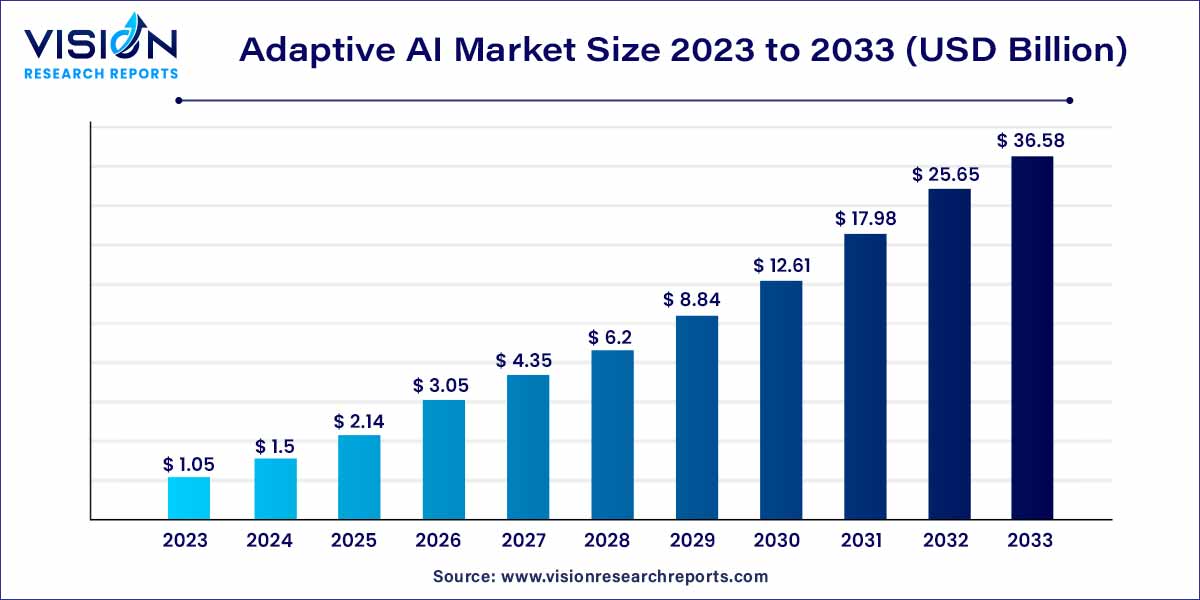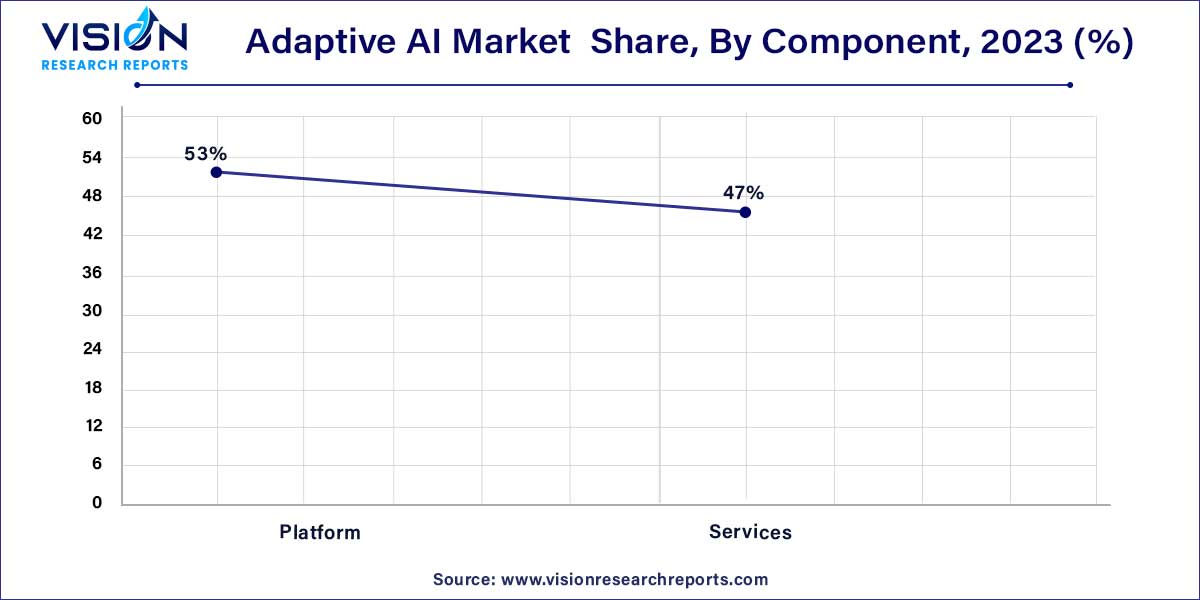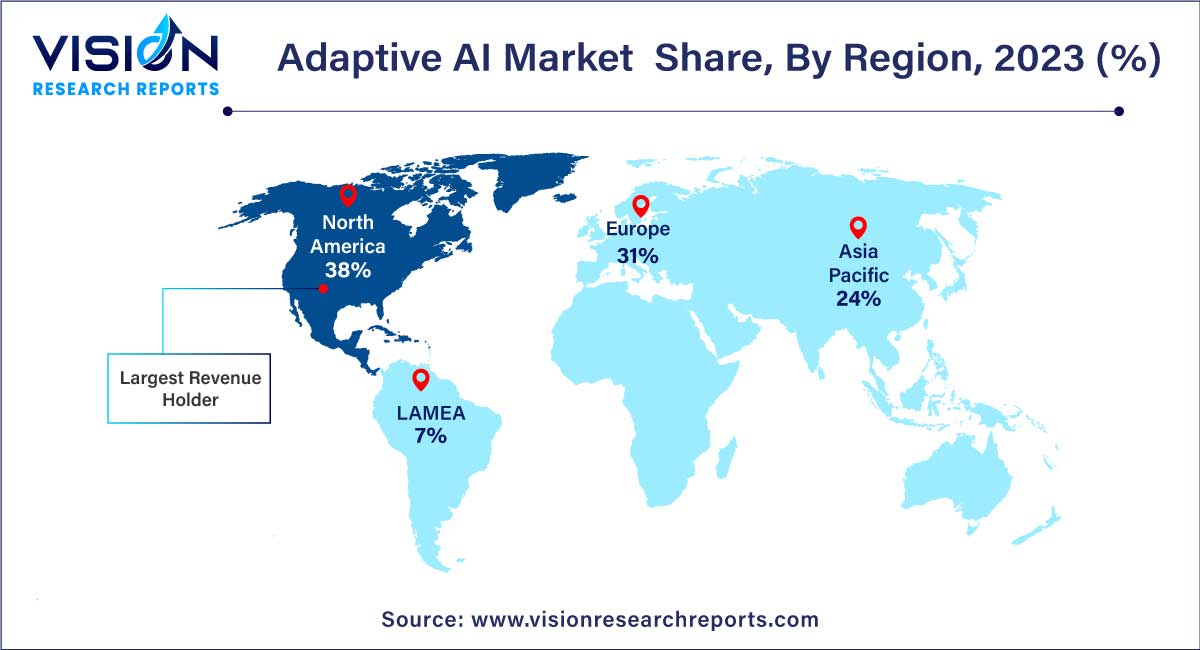The global adaptive AI market size was estimated at around USD 1.05 billion in 2023 and it is projected to hit around USD 36.58 billion by 2033, growing at a CAGR of 42.63% from 2024 to 2033. The adaptive AI market stands at the forefront of technological innovation, representing a pivotal evolution in artificial intelligence (AI) capabilities. Unlike traditional AI systems with predefined algorithms, Adaptive AI introduces a dynamic and self-learning dimension, enabling machines to continually refine their responses based on real-world interactions. This market's significance lies in its potential to revolutionize the way AI systems perceive, process, and adapt to complex information.

The growth of the adaptive AI market is propelled by several key factors. Firstly, the increasing demand for real-time, responsive AI solutions across diverse industries fuels market expansion. The ability of Adaptive AI to autonomously learn and adapt in dynamic environments aligns with the evolving needs of businesses seeking agile and efficient systems. Additionally, advancements in machine learning algorithms, particularly in the deep learning and neural networks, contribute significantly to the market's growth. The proliferation of large datasets and the enhanced processing capabilities of cloud computing further amplify the effectiveness of adaptive AI applications. As industries such as healthcare, finance, and manufacturing increasingly recognize the transformative potential of Adaptive AI in improving decision-making processes and operational efficiency, the market is positioned for sustained growth.
| Report Coverage | Details |
| Growth Rate from 2024 to 2033 | CAGR of 42.63% |
| Market Revenue by 2033 | USD 36.58 billion |
| Revenue Share of North America in 2023 | 38% |
| CAGR of Asia Pacific from 2024 to 2033 | 45.48% |
| Base Year | 2023 |
| Forecast Period | 2024 to 2033 |
| Market Analysis (Terms Used) | Value (US$ Million/Billion) or (Volume/Units) |
Predictive Analytics Advancements: The integration of Adaptive AI in predictive analytics offers opportunities for enhanced forecasting accuracy. Industries can leverage the real-time adaptability of these systems to analyze complex datasets and make more informed predictions, leading to improved decision-making and resource optimization.
Human-AI Collaboration: Opportunities arise from fostering collaboration between humans and Adaptive AI systems. By emphasizing human-AI synergy, organizations can unlock new levels of productivity and creativity. Adaptive AI can assist human workers by automating routine tasks, allowing them to focus on more complex and strategic aspects of their roles.
The platform segment held the largest revenue share of 53% in 2022. An adaptive AI platform is a state-of-the-art method of artificial intelligence that integrates dynamic and adaptable learning capabilities. To build systems that can adapt and change over time, it blends sophisticated machine learning and deep learning techniques with more conventional AI techniques. An adaptive AI platform's primary characteristic is its capacity to learn new things on a regular basis and enhance its functionality through user and data interactions. An adaptive AI platform, for instance, can modify its diagnosis and treatment recommendations in the healthcare industry in response to the most recent findings and patient outcomes.

Significant advancement in data modernization is augmenting the market growth. With its real-time data analysis capabilities, it can improve the way the current systems operate when used effectively.
The offline learning and adaptation segment held the highest revenue share of 29% in 2022. An adaptive AI system's ability to learn and adapt offline is crucial as it allows the system to keep becoming better even in the absence of human interactions or real-time data sources. These procedures guarantee that, in dynamic contexts, the AI system can continue to function effectively and stay current. The ability of an AI to increase its knowledge and proficiency through the analysis of pre-collected information or historical data is known as "offline learning." Instead of depending on real-time data streams, it makes use of historical data to improve its models and tactics
The real-time adaptive AI segment is expected to grow with a CAGR of 46.43% over a forecast period. In real-time, systems using adaptive AI are built to learn from fresh information and experiences as they arise continuously. In real-time, they may enhance their performance, refresh their knowledge, and improve their models. This feature is essential for applications such as financial trading, weather forecasting, and autonomous driving, where data is constantly changing. Moreover, these artificial intelligence systems have a keen sense of the circumstances at hand.
The deep learning segment dominated the market with a revenue share of 34% in 2022. Deep learning algorithms can perform several repetitive and routine tasks more efficiently than human beings. In addition, it can also guarantee the quality of the work and provides additional features like key insights. Thus, implementing deep learning use within organizations can save time and money, which eventually frees up the employees to perform creative tasks that require human participation. Therefore, deep learning is considered a disruptive technology across several end-use industries, uplifting the demand for technology during the forecast period.
One key component that makes adaptable AI systems possible is reinforcement learning, machine learning, and artificial intelligence (AI) agents are trained to maximize a cumulative reward signal through a series of decisions. With the help of this reward-driven learning mechanism, AI systems can gradually modify and enhance behavior. Using RL into adaptive AI has several significant benefits.
The BFSI segment contributed the largest market share of 21% in 2022. Prominent use of adaptive AI in financial industries is propelling the market growth over the forecast period. Fraudulent activity is a persistent threat to financial institutions. Proactive fraud detection and prevention are made possible by adaptive AI's ability to scan enormous volumes of data, spot patterns, and spot abnormalities in real-time. Moreover, using consumer data analysis, adaptive AI systems may provide highly customized banking experiences. Adaptive AI improves client happiness and engagement through individualized financial advice and tailored product recommendations.
The healthcare & life sciences segment is expected to grow at the fastest CAGR of 45.83% over the forecast period. The introduction of adaptive AI is one of the most revolutionary developments in the continuously changing world of healthcare. To improve healthcare diagnosis and treatment procedures, artificial intelligence (AI) technology is integrated. AI continuously learns, adapts, and gets better over time. Adaptive AI analyzes and learns from massive volumes of medical data, honing its predictions and suggestions using complex algorithms and machine learning techniques.
North America accounted for the highest revenue share of 38% in 2023. Adaptive AI is being widely used in healthcare in North America. Personalized treatment plans, predictive analytics, and real-time patient monitoring are all made possible by adaptive AI in hospitals and other medical facilities. Due to technology, medical professionals can always modify their diagnostic and treatment plans considering new findings in the field and information about specific patients. Moreover, Adaptive AI plays a major role in the development of robots, drones, and autonomous vehicles in North America.

The Asia Pacific region is expected to expand at the highest CAGR of 45.48% over the forecast period. In the Asia Pacific region, Adaptive AI is making significant inroads and driving innovation across a wide range of industries. Several factors contribute to the growth of Adaptive AI in this region, including the presence of tech-savvy markets, a rapidly expanding digital landscape, and an increasing focus on AI-driven solutions. Asia Pacific Healthcare is implementing adaptive AI to improve patient care and medical research. Healthcare facilities in nations like South Korea and Japan are utilizing Adaptive AI to provide individualized treatment plans, detect diseases early, and dynamically modify medical procedures.
By Component
By Application
By Technology
By End-use
By Region
Chapter 1. Introduction
1.1. Research Objective
1.2. Scope of the Study
1.3. Definition
Chapter 2. Research Methodology
2.1. Research Approach
2.2. Data Sources
2.3. Assumptions & Limitations
Chapter 3. Executive Summary
3.1. Market Snapshot
Chapter 4. Market Variables and Scope
4.1. Introduction
4.2. Market Classification and Scope
4.3. Industry Value Chain Analysis
4.3.1. Raw Material Procurement Analysis
4.3.2. Sales and Distribution Channel Analysis
4.3.3. Downstream Buyer Analysis
Chapter 5. COVID 19 Impact on Adaptive AI Market
5.1. COVID-19 Landscape: Adaptive AI Industry Impact
5.2. COVID 19 - Impact Assessment for the Industry
5.3. COVID 19 Impact: Global Major Government Policy
5.4. Market Trends and Opportunities in the COVID-19 Landscape
Chapter 6. Market Dynamics Analysis and Trends
6.1. Market Dynamics
6.1.1. Market Drivers
6.1.2. Market Restraints
6.1.3. Market Opportunities
6.2. Porter’s Five Forces Analysis
6.2.1. Bargaining power of suppliers
6.2.2. Bargaining power of buyers
6.2.3. Threat of substitute
6.2.4. Threat of new entrants
6.2.5. Degree of competition
Chapter 7. Competitive Landscape
7.1.1. Company Market Share/Positioning Analysis
7.1.2. Key Strategies Adopted by Players
7.1.3. Vendor Landscape
7.1.3.1. List of Suppliers
7.1.3.2. List of Buyers
Chapter 8. Global Adaptive AI Market, By Component
8.1. Adaptive AI Market, by Component, 2024-2033
8.1.1. Platform
8.1.1.1. Market Revenue and Forecast (2021-2033)
8.1.2. Services
8.1.2.1. Market Revenue and Forecast (2021-2033)
Chapter 9. Global Adaptive AI Market, By Application
9.1. Adaptive AI Market, by Application, 2024-2033
9.1.1. Real-time Adaptive AI
9.1.1.1. Market Revenue and Forecast (2021-2033)
9.1.2. Offline Learning and Adaptation
9.1.2.1. Market Revenue and Forecast (2021-2033)
9.1.3. Context-aware Adaptation
9.1.3.1. Market Revenue and Forecast (2021-2033)
9.1.4. Autonomous Decision-Making
9.1.4.1. Market Revenue and Forecast (2021-2033)
9.1.5. Others
9.1.5.1. Market Revenue and Forecast (2021-2033)
Chapter 10. Global Adaptive AI Market, By Technology
10.1. Adaptive AI Market, by Technology, 2024-2033
10.1.1. Machine Learning
10.1.1.1. Market Revenue and Forecast (2021-2033)
10.1.2. Deep Learning
10.1.2.1. Market Revenue and Forecast (2021-2033)
10.1.3. Reinforcement Learning
10.1.3.1. Market Revenue and Forecast (2021-2033)
10.1.4. Natural Language Processing (NLP)
10.1.4.1. Market Revenue and Forecast (2021-2033)
10.1.5. Computer Vision
10.1.5.1. Market Revenue and Forecast (2021-2033)
Chapter 11. Global Adaptive AI Market, By End-use
11.1. Adaptive AI Market, by End-use, 2024-2033
11.1.1. BFSI
11.1.1.1. Market Revenue and Forecast (2021-2033)
11.1.2. Healthcare & Life Sciences
11.1.2.1. Market Revenue and Forecast (2021-2033)
11.1.3. IT & Telecommunications
11.1.3.1. Market Revenue and Forecast (2021-2033)
11.1.4. Aerospace & Defense
11.1.4.1. Market Revenue and Forecast (2021-2033)
11.1.5. Manufacturing
11.1.5.1. Market Revenue and Forecast (2021-2033)
11.1.6. Retail & E-commerce
11.1.6.1. Market Revenue and Forecast (2021-2033)
11.1.7. Media & Entertainment
11.1.7.1. Market Revenue and Forecast (2021-2033)
11.1.8. Others
11.1.8.1. Market Revenue and Forecast (2021-2033)
Chapter 12. Global Adaptive AI Market, Regional Estimates and Trend Forecast
12.1. North America
12.1.1. Market Revenue and Forecast, by Component (2021-2033)
12.1.2. Market Revenue and Forecast, by Application (2021-2033)
12.1.3. Market Revenue and Forecast, by Technology (2021-2033)
12.1.4. Market Revenue and Forecast, by End-use (2021-2033)
12.1.5. U.S.
12.1.5.1. Market Revenue and Forecast, by Component (2021-2033)
12.1.5.2. Market Revenue and Forecast, by Application (2021-2033)
12.1.5.3. Market Revenue and Forecast, by Technology (2021-2033)
12.1.5.4. Market Revenue and Forecast, by End-use (2021-2033)
12.1.6. Rest of North America
12.1.6.1. Market Revenue and Forecast, by Component (2021-2033)
12.1.6.2. Market Revenue and Forecast, by Application (2021-2033)
12.1.6.3. Market Revenue and Forecast, by Technology (2021-2033)
12.1.6.4. Market Revenue and Forecast, by End-use (2021-2033)
12.2. Europe
12.2.1. Market Revenue and Forecast, by Component (2021-2033)
12.2.2. Market Revenue and Forecast, by Application (2021-2033)
12.2.3. Market Revenue and Forecast, by Technology (2021-2033)
12.2.4. Market Revenue and Forecast, by End-use (2021-2033)
12.2.5. UK
12.2.5.1. Market Revenue and Forecast, by Component (2021-2033)
12.2.5.2. Market Revenue and Forecast, by Application (2021-2033)
12.2.5.3. Market Revenue and Forecast, by Technology (2021-2033)
12.2.5.4. Market Revenue and Forecast, by End-use (2021-2033)
12.2.6. Germany
12.2.6.1. Market Revenue and Forecast, by Component (2021-2033)
12.2.6.2. Market Revenue and Forecast, by Application (2021-2033)
12.2.6.3. Market Revenue and Forecast, by Technology (2021-2033)
12.2.6.4. Market Revenue and Forecast, by End-use (2021-2033)
12.2.7. France
12.2.7.1. Market Revenue and Forecast, by Component (2021-2033)
12.2.7.2. Market Revenue and Forecast, by Application (2021-2033)
12.2.7.3. Market Revenue and Forecast, by Technology (2021-2033)
12.2.7.4. Market Revenue and Forecast, by End-use (2021-2033)
12.2.8. Rest of Europe
12.2.8.1. Market Revenue and Forecast, by Component (2021-2033)
12.2.8.2. Market Revenue and Forecast, by Application (2021-2033)
12.2.8.3. Market Revenue and Forecast, by Technology (2021-2033)
12.2.8.4. Market Revenue and Forecast, by End-use (2021-2033)
12.3. APAC
12.3.1. Market Revenue and Forecast, by Component (2021-2033)
12.3.2. Market Revenue and Forecast, by Application (2021-2033)
12.3.3. Market Revenue and Forecast, by Technology (2021-2033)
12.3.4. Market Revenue and Forecast, by End-use (2021-2033)
12.3.5. India
12.3.5.1. Market Revenue and Forecast, by Component (2021-2033)
12.3.5.2. Market Revenue and Forecast, by Application (2021-2033)
12.3.5.3. Market Revenue and Forecast, by Technology (2021-2033)
12.3.5.4. Market Revenue and Forecast, by End-use (2021-2033)
12.3.6. China
12.3.6.1. Market Revenue and Forecast, by Component (2021-2033)
12.3.6.2. Market Revenue and Forecast, by Application (2021-2033)
12.3.6.3. Market Revenue and Forecast, by Technology (2021-2033)
12.3.6.4. Market Revenue and Forecast, by End-use (2021-2033)
12.3.7. Japan
12.3.7.1. Market Revenue and Forecast, by Component (2021-2033)
12.3.7.2. Market Revenue and Forecast, by Application (2021-2033)
12.3.7.3. Market Revenue and Forecast, by Technology (2021-2033)
12.3.7.4. Market Revenue and Forecast, by End-use (2021-2033)
12.3.8. Rest of APAC
12.3.8.1. Market Revenue and Forecast, by Component (2021-2033)
12.3.8.2. Market Revenue and Forecast, by Application (2021-2033)
12.3.8.3. Market Revenue and Forecast, by Technology (2021-2033)
12.3.8.4. Market Revenue and Forecast, by End-use (2021-2033)
12.4. MEA
12.4.1. Market Revenue and Forecast, by Component (2021-2033)
12.4.2. Market Revenue and Forecast, by Application (2021-2033)
12.4.3. Market Revenue and Forecast, by Technology (2021-2033)
12.4.4. Market Revenue and Forecast, by End-use (2021-2033)
12.4.5. GCC
12.4.5.1. Market Revenue and Forecast, by Component (2021-2033)
12.4.5.2. Market Revenue and Forecast, by Application (2021-2033)
12.4.5.3. Market Revenue and Forecast, by Technology (2021-2033)
12.4.5.4. Market Revenue and Forecast, by End-use (2021-2033)
12.4.6. North Africa
12.4.6.1. Market Revenue and Forecast, by Component (2021-2033)
12.4.6.2. Market Revenue and Forecast, by Application (2021-2033)
12.4.6.3. Market Revenue and Forecast, by Technology (2021-2033)
12.4.6.4. Market Revenue and Forecast, by End-use (2021-2033)
12.4.7. South Africa
12.4.7.1. Market Revenue and Forecast, by Component (2021-2033)
12.4.7.2. Market Revenue and Forecast, by Application (2021-2033)
12.4.7.3. Market Revenue and Forecast, by Technology (2021-2033)
12.4.7.4. Market Revenue and Forecast, by End-use (2021-2033)
12.4.8. Rest of MEA
12.4.8.1. Market Revenue and Forecast, by Component (2021-2033)
12.4.8.2. Market Revenue and Forecast, by Application (2021-2033)
12.4.8.3. Market Revenue and Forecast, by Technology (2021-2033)
12.4.8.4. Market Revenue and Forecast, by End-use (2021-2033)
12.5. Latin America
12.5.1. Market Revenue and Forecast, by Component (2021-2033)
12.5.2. Market Revenue and Forecast, by Application (2021-2033)
12.5.3. Market Revenue and Forecast, by Technology (2021-2033)
12.5.4. Market Revenue and Forecast, by End-use (2021-2033)
12.5.5. Brazil
12.5.5.1. Market Revenue and Forecast, by Component (2021-2033)
12.5.5.2. Market Revenue and Forecast, by Application (2021-2033)
12.5.5.3. Market Revenue and Forecast, by Technology (2021-2033)
12.5.5.4. Market Revenue and Forecast, by End-use (2021-2033)
12.5.6. Rest of LATAM
12.5.6.1. Market Revenue and Forecast, by Component (2021-2033)
12.5.6.2. Market Revenue and Forecast, by Application (2021-2033)
12.5.6.3. Market Revenue and Forecast, by Technology (2021-2033)
12.5.6.4. Market Revenue and Forecast, by End-use (2021-2033)
Chapter 13. Company Profiles
13.1. Risingmax
13.1.1. Company Overview
13.1.2. Product Offerings
13.1.3. Financial Performance
13.1.4. Recent Initiatives
13.2. Suffescom Solutions
13.2.1. Company Overview
13.2.2. Product Offerings
13.2.3. Financial Performance
13.2.4. Recent Initiatives
13.3. Markovate
13.3.1. Company Overview
13.3.2. Product Offerings
13.3.3. Financial Performance
13.3.4. Recent Initiatives
13.4. Dynam.Ai
13.4.1. Company Overview
13.4.2. Product Offerings
13.4.3. Financial Performance
13.4.4. Recent Initiatives
13.5. Leewayhertz
13.5.1. Company Overview
13.5.2. Product Offerings
13.5.3. Financial Performance
13.5.4. Recent Initiatives
13.6. Cygnus Software
13.6.1. Company Overview
13.6.2. Product Offerings
13.6.3. Financial Performance
13.6.4. Recent Initiatives
13.7. Ness Digital Engineering
13.7.1. Company Overview
13.7.2. Product Offerings
13.7.3. Financial Performance
13.7.4. Recent Initiatives
13.8. Softura
13.8.1. Company Overview
13.8.2. Product Offerings
13.8.3. Financial Performance
13.8.4. Recent Initiatives
13.9. Apexon
13.9.1. Company Overview
13.9.2. Product Offerings
13.9.3. Financial Performance
13.9.4. Recent Initiatives
Chapter 14. Research Methodology
14.1. Primary Research
14.2. Secondary Research
14.3. Assumptions
Chapter 15. Appendix
15.1. About Us
15.2. Glossary of Terms
 Cross-segment Market Size and Analysis for
Mentioned Segments
Cross-segment Market Size and Analysis for
Mentioned Segments
 Additional Company Profiles (Upto 5 With No Cost)
Additional Company Profiles (Upto 5 With No Cost)
 Additional Countries (Apart From Mentioned Countries)
Additional Countries (Apart From Mentioned Countries)
 Country/Region-specific Report
Country/Region-specific Report
 Go To Market Strategy
Go To Market Strategy
 Region Specific Market Dynamics
Region Specific Market Dynamics Region Level Market Share
Region Level Market Share Import Export Analysis
Import Export Analysis Production Analysis
Production Analysis Others
Others